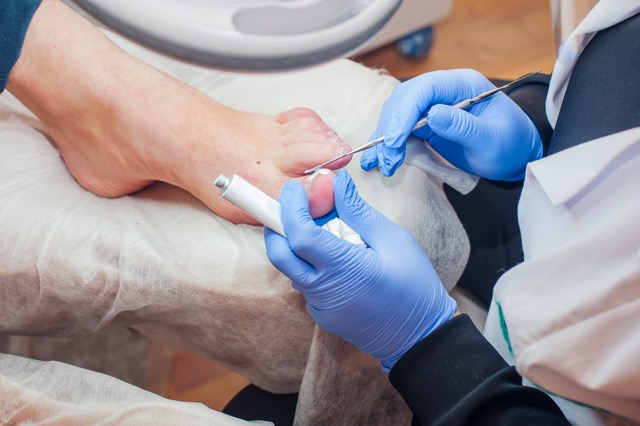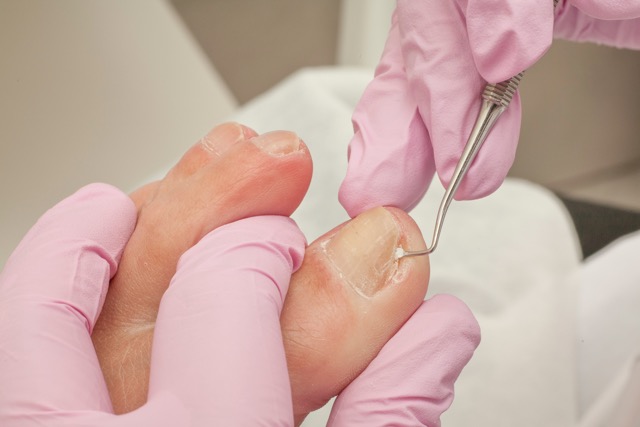Everything You Need to Know About Ingrown Nails
Unsightly and painful to have, ingrown nails are an all-too-common problem. In this article, we’ll discuss what causes them, how to treat them at home, and when you should come to us for treatment. By the end, you’ll know everything you need to know about ingrown toenails so you can get back on your feet and enjoy your life!
What is an Ingrown Nail?
An ingrown nail is a type of foot condition that develops when the corner of the toenail grows into the skin. It is most commonly seen in the big toe, however, can occur on other toes as well.
Ingrown Nail Symptoms
Ingrown toenails can be quite debilitating. Symptoms may include:
Pain
The most common symptom of an ingrown toenail is pain. This pain can range from mild discomfort to severe, throbbing pain. The pain is typically worse when pressure is applied to the toe, such as when wearing shoes.
Swelling
Another common symptom is swelling. This can occur in the toe itself or the surrounding tissue. In some cases, the toe may become so swollen that it is difficult to wear shoes.
Redness
Redness is another common symptom of an ingrown nail and is usually the result of inflammation.
Infection
If the ingrown toenail is left untreated, it can lead to an infection. Symptoms of an infection may include pus, redness, and heat in the affected area. In severe cases, the infection may spread to other parts of the body.

What Causes Ingrown Toenails?
Several factors can contribute to the development of an ingrown toenail. These include:
Poorly Cut Toenails
If the toenails are not properly trimmed, they can become ingrown. This is especially common if the nails are cut too short or if they are not cut straight across.
Ill-Fitting Shoes
Tight shoes can also contribute to the development of ingrown toenails. This is because they can place pressure on the toes, which can cause the nails to grow into the skin.
Injury
Physical trauma like stubbing your toe or dropping something on your foot can also cause an ingrown toenail. This type of injury can damage the nail, causing it to grow into the skin.
Tearing the Corner of the Nail
If the corner of the nail is ripped off, it can leave a jagged edge. This jagged edge can then grow into the skin, causing an ingrown toenail.
Congenital Predisposition
Believe it or not, genetics can play a role in the development of ingrown toenails. If you have family members who have had this condition, you may be more likely to develop it as well.
How are Ingrown Toenails Diagnosed?
Ingrown toenails are typically diagnosed based on a physical examination. Our doctor will look for typical symptoms, such as pain, swelling, and redness. In some cases, X-rays may be ordered to rule out other conditions that can cause similar symptoms.

Treatment Options for Ingrown Nails
Treatment for an ingrown toenail typically depends on the severity of the condition. For mild cases, home treatment may be all that is necessary. However, in more severe cases, medical treatment may be necessary.
At-Home Treatment Options
At-home treatments can be an easy way to get rid of an ingrown toenail. These treatments can help to reduce pain and inflammation and allow the nail to grow back properly.
Soak in Warm Water
One simple at-home treatment is to soak the affected foot in warm water for 15-20 minutes, several times per day. This can help to reduce pain and inflammation. Epsom salts can also be added to the water to help decrease swelling.
Wear Loose-Fitting Shoes
Wearing loose-fitting shoes can also help to reduce pain and inflammation. This is because tight shoes can put pressure on the toes, which can exacerbate symptoms.
Apply a Warm Compress
Another at-home treatment is to apply a warm compress to the affected area. This can be done by soaking a clean cloth in warm water and then applying it to the toe for 10-15 minutes.
Place a Cotton Ball Under the Nail
Another simple treatment is to place a small piece of cotton under the nail. This can help to reduce pressure on the nail and allow it to grow back properly. However, don’t cut into the skin to dig out the nail as this can lead to infection.
Keep Feet Dry and Clean
It’s also important to keep the feet clean and dry. This means washing them regularly with soap and water and drying them thoroughly. Doing this can help to prevent infection.
In-Office Treatments
In more severe cases of ingrown toenails, medical treatment may be necessary. This is typically done on an outpatient basis and does not require a hospital stay.
Nail Lift
One treatment option is a nail lift. This is a procedure in which the corner of the nail is lifted so that it no longer grows into the skin. A nail lift can be done using a special tool or a chemical solution.
Partial or Total Removal of the Nail
In more severe cases, the entire nail may need to be removed. This is typically done as a last resort and only when other treatments have failed. Partial or total removal of the nail is typically done using a local anesthetic.
When to See a Doctor
There are some cases when home treatment is not enough and medical treatment is necessary. This includes those with:
Diabetes or Other Health Conditions
If you have diabetes or another health condition that affects the nerve endings of the foot, it’s important to see our doctor as soon as possible. This is because these conditions can make it difficult to perceive the severity of an ingrown nail and increase the risks of complications.
Poor Blood Circulation
If you have preexisting or have noticed the onset of poor blood circulation in your feet, it’s important to see Dr. Timson. This is because poor circulation can lead to more serious complications, such as an infection.
Signs of Infection
If you notice any signs of infection, such as redness, swelling, or pus, it’s important to come to see our office right away. This is because the infection can quickly become serious and lead to complications.
Don’t Let an Ingrown Toenail Slow You Down
At Community Foot Clinic of McPherson, we understand how painful and frustrating an ingrown toenail can be. That’s why we offer a variety of treatment options to help you get relief. To learn more or to schedule an appointment, give us a call today. We look forward to helping you get back on your feet!
One System, Many Applications
Laser therapy is not merely a one-trick pony; it serves as a versatile treatment option for addressing a spectrum of foot and ankle issues. While commonly associated with heel pain relief, its efficacy extends far beyond, effectively targeting chronic soft tissue pain stemming from conditions such as Achilles tendinitis, plantar fasciitis, and Morton's neuroma.
By providing targeted relief, laser therapy restores mobility and improves the quality of life for patients suffering from these debilitating conditions.
Exploring Other Sources of Chronic Soft Tissue Pain
Chronic soft tissue pain can significantly impact daily life, hindering mobility and diminishing overall well-being. Laser therapy offers a beacon of hope for individuals grappling with conditions beyond heel pain.
Whether it's addressing Achilles tendinitis, characterized by inflammation of the Achilles tendon, or alleviating the discomfort associated with Morton's neuroma, laser therapy presents a non-invasive solution that promotes healing and reduces pain.
Addressing Traumatic Soft Tissue Injuries
Traumatic injuries such as sprains, strains, and contusions are all too common in the foot and ankle region, often causing acute pain and swelling. Laser therapy accelerates the healing process by promoting tissue repair and reducing inflammation.
By harnessing the power of targeted light energy, laser therapy expedites recovery, enabling patients to regain function and resume their daily activities with minimal delay.
Mitigating Neuropathic Pain
Neuropathy poses unique challenges, manifesting as tingling, burning, and shooting pain in the feet due to nerve damage. Laser therapy offers a promising avenue for managing neuropathic pain by stimulating nerve regeneration and improving nerve function. This holistic approach not only alleviates symptoms but also enhances the overall quality of life for individuals living with neuropathy.
Supporting Recovery Alongside Surgery
Laser therapy plays a vital role in complementing surgical interventions for various foot and ankle conditions. Post-surgery, it aids in tissue healing, reduces scar tissue formation, and minimizes post-operative pain. By integrating laser therapy into treatment plans, healthcare providers can optimize surgical outcomes and facilitate smoother recovery trajectories for patients.
Fostering Expedited Wound Healing
Chronic or non-healing foot ulcers and wounds pose significant challenges, often requiring comprehensive wound care solutions. Laser therapy emerges as a valuable adjunct to wound healing protocols, promoting blood flow, enhancing tissue repair, and creating an optimal environment for healing. With laser therapy, patients experience accelerated wound closure, reduced risk of complications, and improved overall outcomes.
McPherson Office
316 W. 4th Street
McPherson, KS 67460
P: (620) 241-3313
F: (620) 241-6967
© Community Foot Clinic of McPherson. All Rights Reserved.
Privacy Policy | Terms & Conditions
Web Design by CP Solutions
Marketed by VMD Services
